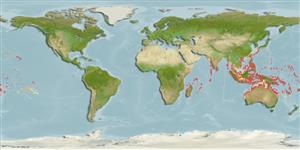Common names from other countries
>
Eupercaria/misc (Various families in series Eupercaria) >
Caesionidae (Fusiliers) > Caesioninae
Etymology: Pterocaesio: Greek, pteron = wing, fin + Latin, caesius = blue grey (Ref. 45335).
Eponymy: Professor John C Marr was head of the South Pacific Fishery Investigations of the US Fish and Wildlife Service. [...] (Ref. 128868), visit book page.
More on author: Schultz.
Environment: milieu / climate zone / rango de profundidad / distribution range
Ecología
marino asociado a arrecife; no migratorio; rango de profundidad 1 - 30 m (Ref. 58018), usually ? - 10 m (Ref. 89972). Tropical; 34°N - 31°S, 39°E - 133°W (Ref. 402)
Indo-Pacific: East Africa, not including the Red Sea or the Arabian (Persian) Gulf, to the Marquesas Islands.
Tamaño / Peso / Age
Madurez: Lm ? range ? - ? cm
Max length : 35.0 cm TL macho / no sexado; (Ref. 402)
Espinas dorsales (total) : 10 - 11; Radios blandos dorsales (total) : 14 - 16; Espinas anales: 3; Radios blandos anales: 11 - 13. Upper body blue to greenish, lower whitish. 4-6 cheek scales; 24-32 predorsal rays; scaled dorsal and anal fins. Upper peduncular scale rows usually 12 or 13 (12-14); lower peduncular scale rows usually 16 or 17 (15-17). Post maxillary processes 2; posterior end of maxilla tapered. The process on ventrolateral surface of basioccipital for attachment of Baudelot's ligament not extending beyond a horizontal with condyle's rim (Ref. 1723). Caudal fin lobes with dark tips. Head length 3.0-3.7 in SL; body depth 3.4-4.6 in SL (Ref. 90102).
Body shape (shape guide): fusiform / normal; Cross section: compressed.
Ranges widely around coral reefs (Ref. 58652) and appears to prefer clear waters of oceanic islands or reefs far from large land masses. Feeds on zooplankton in midwater aggregations. Oviparous, with numerous, small pelagic eggs (Ref. 402). Also caught by drive-in nets. Used as tuna baitfish.
Life cycle and mating behavior
Madurez | Reproducción | Puesta | Huevos | Fecundidad | Larva
Carpenter, K.E., 1987. Revision of the Indo-Pacific fish family Caesionidae (Lutjanoidea), with descriptions of five new species. Indo-Pac. Fish. (15):56 p. (Ref. 1723)
IUCN Red List Status (Ref. 130435: Version 2025-1)
Threat to humans
Harmless
Human uses
Pesquerías: escaso valor comercial; carnada: occasionally
Herramientas
Special reports
Download XML
Fuentes de Internet
Estimates based on models
Preferred temperature (Referencia
123201): 25.2 - 29.3, mean 28.5 °C (based on 3174 cells).
Phylogenetic diversity index (Referencia
82804): PD
50 = 0.5002 [Uniqueness, from 0.5 = low to 2.0 = high].
Bayesian length-weight: a=0.01072 (0.00469 - 0.02447), b=3.11 (2.93 - 3.29), in cm total length, based on LWR estimates for this Genus-body shape (Ref.
93245).
Nivel trófico (Referencia
69278): 3.4 ±0.45 se; based on food items.
Resiliencia (Referencia
120179): Alto, población duplicada en un tiempo mínimo inferior a 15 meses (Preliminary K or Fecundity.).
Fishing Vulnerability (Ref.
59153): Low vulnerability (25 of 100).
🛈
Nutrients (Ref.
124155): Calcium = 60.6 [39.7, 90.7] mg/100g; Iron = 0.746 [0.488, 1.094] mg/100g; Protein = 19.1 [18.1, 20.0] %; Omega3 = 0.134 [0.092, 0.195] g/100g; Selenium = 29.3 [18.5, 50.1] μg/100g; VitaminA = 103 [42, 258] μg/100g; Zinc = 1.16 [0.84, 1.55] mg/100g (wet weight);
